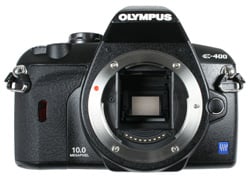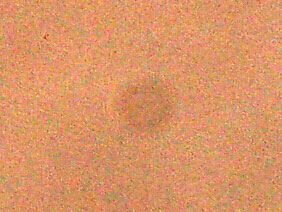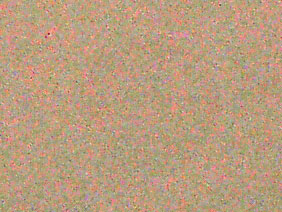Olympus E-400 with Zuiko Digital 14-42mm f3.5-5.6 ED
-
-
Written by Gordon Laing
Olympus E-400 anti dust
Olympus E-400 features
Lenses and viewfinder / Screen and menus / Sensor and processing / Anti dust
Like previous E-Series digital SLRs along with the Panasonic L1, the Olympus E-400 employs a SuperSonic Wave Filter to combat the problem of dust entering the body and casting annoying shadows onto the sensor. The SSWF system is widely regarded as one of the most effective in the industry, so we were keen to see how it would perform in practice.
The SSWF vibrates a special filter in front of the sensor in an attempt to shake-free any foreign particles which have entered the body. Unlike rival anti-dust systems though, the Four Thirds standard allows for the vibrating filter to be positioned further from the sensor itself. This helps a great deal, as any dust which remains is normally so far from the focal plane, it’s essentially rendered invisible at all but the smallest apertures.
 | |
This is an important point to mention as the E-400 actually employs a brand new SSWF system which is physically smaller than is predecessors in order to squeeze into the compact body. Olympus has also increased the frequency of the vibrating filter, but wouldn’t disclose the new frequency nor the shorter distance between the filter and sensor. The big question then is whether the new system is more or less effective than the old one.
At this point it’s important to note the evaluation of anti-dust dust systems can never be as controlled or consistent as other tests. After all, there’s no way of counting the number or type of dust particles which currently lie within a body, nor any way to introduce a consistent number of test particles for it to subsequently get rid off. As such it’s impossible to conclude one system is categorically better than another at eliminating dust.
Just because something can’t be scientifically measured though, doesn’t mean it should be glossed-over or ignored in a review. Dust is the number-one complaint for many DSLR owners and anti-dust systems have become some of the most talked-about and desirable features in new bodies. As such even anecdotal evidence is valuable and by gathering it from a number of sources over time we can build up a picture of how effective, or ineffective a system performs. That’s our belief at Camera Labs, so for the record here’s what we found.
 |
|
First things first: like earlier E-Series DSLRs and the Lumix L1, the E-400 performs its SSWF anti-dust process every time the camera’s switched on and there’s no way to override it. Interestingly though, unlike earlier Olympus DSLRs, the E-400 doesn’t slow down the startup process by showing an animation advertising the SSWF system.
If there’s no memory card present, the animation is shown, but if one has been inserted, the only indication of the cleaning process taking place is a small blue light by the shutter release which flickers for just under a second during power-up. Olympus says it removed the animation as the SSWF process was now well-known and understood.
This is actually the same approach as the Panasonic Lumix L1, and allows both cameras to startup in just over a second – this may sound like an age compared to the 0.18 second startups of the latest Nikon bodies, but it’s not too bad in practice and a great improvement over earlier Olympus DSLRs.
Now to our anecdotal evidence. When examining our test shots with the E-400, there were no obvious dust marks, so like the Lumix L1, we deliberately took much less care when changing lenses to see how the system would cope.
We removed the lens from the E-400 and left the body open and face-up indoors for five minutes. We then repeated this outdoors on a blustery day, again for five minutes. Again while there’s no way of knowing exactly how much dust got into the body, we’re pretty confident such activity would have resulted in many visible dust marks on other DSLRs.
The easiest way to spot dust marks is to manually focus the lens to infinity and shoot a plain white surface from about 30cm away. It’s revealing to try this at different apertures, as the bigger the f-number, the sharper and more defined any dust marks will become. So the ultimate torture test would be at, say, f22, although to be fair it’s important to also test at the more common apertures used day-to-day.
We photographed the white surface as described with each aperture setting, then opened the images in Photoshop and zoomed-in to 100% for close examination using a calibrated Eizo CG210 monitor. We’re pleased to report not a single dust mark was visible on any of the images, even with the aperture closed to f22. Of course the big question was whether the E-400 really was dust-free, or whether the marks just weren’t visible under normal conditions.
To put this to the test we took the image taken at f22 and compressed the levels in Photoshop down from the captured 256 to just 20 around the areas of tonal detail. Under these extreme conditions, we spotted a single dust mark near the bottom, although it was still reasonably faint considering the degree of levels adjustment.
You can see the before and after images below with 100% crops and let us assure you, the seemingly blank portion on the left is from an identical area to the one on the right – if you have a good quality monitor you might just see the faintest patch, but it’s fair to see you wouldn’t notice it unless you knew exactly where to look. If you like, try saving the left image onto your computer and adjusting the levels to see how far you have to go before the mark becomes visible.
Olympus E-400 dust example at f22 | ||
 |  | |
| 100% crop measuring 282×212 pixels | 100% crop measuring 282×212 pixels with Levels | |
We noted the position of the mark on the f22 image then looked for it in the other images using the same compressed levels technique. Even with severely compressed levels though, the mark remained essentially invisible up to f8, where it only became barely visible as a large but very faint patch; you can just see this on the photo below right, and again the sample from the same area without levels adjustment (below left) looks free of dust. Closing the aperture further saw the mark become smaller and better defined as expected.
Olympus E-400 dust example at f8 | ||
 |  | |
| 100% crop measuring 282×212 pixels | 100% crop measuring 282×212 pixels with Levels | |
These tests confirmed the existence of dust settling on the filter even after it had vibrated, but equally prove they’d essentially remain invisible on your photos even at the smallest apertures. Even if you adjusted the levels quite significantly, the marks still wouldn’t appear. They only reveal themselves if you compress the levels to a ridiculous degree.
So once again this is a great result for the SuperSonic Wave Filter, although as discussed in the Lumix L1 review, its resistance to dust is as much to do with the distance between the filter and sensor as it is with the actual vibrating process itself. Either way, following our tests, we’re pretty confident dust marks won’t be an issue for owners of the E-400.




